Are you ready to embark on a culinary adventure with my easy-to-follow Ngo Hiong recipe? This delicious Asian dish is sure to tantalize your taste buds with its savory and flavorful filling. Originating in Eastern China, Ngo Hiong has become a well-loved delicacy known for its unique combination of ground meat seasoned with five-spice powder, wrapped in dried bean curd sheets, and then steamed and deep-fried to perfection.
- Ngo Hiong is a popular Asian dish made with ground meat and an array of flavorful ingredients.
- The filling is wrapped in dried bean curd sheets, steamed, and then deep-fried to achieve a delightful crispy texture.
- It can be prepared ahead of time and frozen for convenience.
- Try out variations such as Filipino Kikiam and Cebu’s Ngoh Hiong Lumpia to explore different flavors and regional influences.
- Serve Ngo Hiong as part of a Chinese meal or enjoy it as a delectable appetizer or snack.
Now that you’ve learned about the origins and flavors of Ngo Hiong, it’s time to don your apron and get cooking! Follow the step-by-step guide in the upcoming sections to create your very own homemade Ngo Hiong masterpiece.
The Origins of Ngo Hiong: A Chinese Delicacy
Ngo Hiong, also known as Ngoh Hiang, is a beloved Asian dish with a rich history that originated in Eastern China. This flavorful delicacy is made by combining ground meat with a variety of ingredients and seasonings, resulting in a savory filling that is wrapped, steamed, and then deep-fried to perfection. With its origins deeply rooted in Chinese cuisine, Ngo Hiong has become a popular dish enjoyed by many across Asia and beyond.
The dish gets its distinct flavor from the use of Chinese five-spice powder, a blend of spices that includes star anise, cloves, cinnamon, Sichuan peppercorns, and fennel seeds. Other key ingredients often found in Ngo Hiong include ground pork, shrimp, water chestnuts, shallots, carrots, and salted egg yolks. These ingredients, when combined and seasoned, create a delectable filling that is then wrapped in dried bean curd sheets, giving the dish its signature appearance.
To prepare Ngo Hiong, the filling is spread onto the bean curd sheets, rolled into sausage-like shapes, and secured with egg white. The rolls are then steamed to ensure the flavors meld together and the filling is cooked through. Once steamed, the rolls are deep-fried until golden and crispy, creating a mouthwatering combination of textures.
The result is a dish that perfectly balances savory and aromatic flavors, making Ngo Hiong a delightful addition to any meal or a satisfying appetizer or snack. Whether you’re a fan of Chinese cuisine or looking to explore new flavors, Ngo Hiong is a dish that should not be missed.
| Ngo Hiong Ingredients | Ngo Hiong Seasoning |
|---|---|
| Ground pork | Chinese five-spice powder |
| Shrimp | Sugar |
| Water chestnuts | Salt |
| Shallots | Fish sauce |
| Carrots | |
| Salted egg yolks |
The Perfect Ngo Hiong Filling: A Burst of Flavors
The filling is the heart and soul of Ngo Hiong, and in this section, I’ll guide you through three mouthwatering recipes – pork, chicken, and vegetarian – to suit all tastes. Each recipe is packed with a delicious combination of ingredients and seasonings that will elevate your Ngo Hiong to a whole new level of flavor.
Pork Ngo Hiong Recipe
This classic recipe uses ground pork as the main ingredient, combined with a medley of aromatic flavors. Mix together the ground pork, minced shrimp, finely chopped water chestnuts, shallots, carrots, salted egg yolks, and a generous sprinkle of Chinese five-spice powder. Season with sugar, salt, and a dash of fish sauce to enhance the savory profile. The result is a rich and flavorful filling that is sure to delight your taste buds.
Chicken Ngo Hiong Recipe
If you prefer a lighter option, the chicken Ngo Hiong recipe is a fantastic choice. Start by using ground chicken instead of pork and follow the same process as the pork recipe. The chicken provides a tender and juicy texture, complementing the aromatic seasonings perfectly. This recipe is a healthier alternative without compromising on taste.
Vegetarian Ngo Hiong Recipe
For those following a vegetarian diet, fear not! You can still enjoy the delicious flavors of Ngo Hiong with this vegetarian recipe. Replace the meat with ingredients like tofu or tempeh, finely chopped vegetables such as mushrooms, carrots, and bell peppers. Season with Chinese five-spice powder, salt, and pepper for a vegetarian filling bursting with umami.
Whichever recipe you choose, the filling plays a crucial role in creating the authentic taste of Ngo Hiong. Experiment with different combinations of ingredients and seasonings to find your perfect flavor profile. Now that you have the recipes at your fingertips, it’s time to get cooking and experience the mouthwatering goodness of Ngo Hiong right in your own kitchen!
In this section, we explored the perfect Ngo Hiong filling with three delectable recipes: pork, chicken, and vegetarian. Each recipe uses unique ingredients and seasonings to create a burst of flavors that will satisfy all tastes. Whether you prefer the classic pork version, a lighter chicken option, or a vegetarian twist, Ngo Hiong offers something for everyone. So why wait? Try these recipes and enjoy the mouthwatering delight of Ngo Hiong today!
Wrapping and Preparing Ngo Hiong: A Step-by-Step Guide
Now that you have your flavorful filling ready, it’s time to learn how to expertly wrap and prepare your Ngo Hiong for cooking. The wrapping process is crucial to ensure that the filling stays intact and the flavors are sealed within.
Start by laying out a piece of bean curd sheet on a clean surface. Place a generous spoonful of the filling mixture onto one end of the sheet, leaving space around the edges for folding. Gently roll the sheet over the filling, tucking in the sides as you go, until you have a tight cylinder.
To secure the wrap, brush some egg white along the edges of the sheet, then press and seal. Repeat this process until all the filling is used up.
Once you have wrapped all your Ngo Hiong rolls, it’s time to cook them. Fill a steamer pot with water and bring it to a boil. Place the Ngo Hiong rolls on a steaming rack, leaving some space between each roll to allow for even cooking. Steam the rolls for about 10-15 minutes until they are cooked through.
After steaming, it’s time to add that irresistible crispiness to your Ngo Hiong. Heat oil in a deep frying pan or wok over medium heat. Carefully lower the steamed rolls into the hot oil and fry until they turn golden brown and crispy on all sides. Remove from the oil and drain on a paper towel to remove any excess oil.
Now your Ngo Hiong is ready to be served! You can enjoy it as a main dish with steamed rice and your favorite dipping sauce or serve it as an appetizer or snack. The combination of the savory filling and crispy exterior is sure to delight your taste buds.
- To ensure the filling stays intact while wrapping, make sure it is not too wet. If necessary, drain any excess liquid before using it.
- When wrapping the Ngo Hiong rolls, keep the roll tight and secure to prevent the filling from oozing out during cooking.
- For a healthier option, you can also bake the Ngo Hiong rolls in the oven instead of deep-frying them. Simply brush the rolls with some oil and bake at 375°F for 20-25 minutes, turning them halfway through the cooking process.
Now that you’ve mastered the art of wrapping and preparing Ngo Hiong, it’s time to enjoy the delectable flavors of this Asian delicacy. Whether you’re making it for a special occasion or simply craving a flavorful snack, Ngo Hiong is a dish that is sure to impress. Happy cooking!
Steaming and Deep-Frying Ngo Hiong: Achieving the Perfect Crispiness
To create that irresistible crunch, steaming and deep-frying are essential steps in preparing your Ngo Hiong. Steaming helps to cook the filling, allowing the flavors to infuse and meld together, while deep-frying adds the golden, crispy exterior that makes this dish so satisfying.
When steaming Ngo Hiong, it’s important to use a steamer lined with parchment paper or cabbage leaves to prevent sticking. Arrange the wrapped Ngo Hiong in a single layer to ensure even cooking. Steam for about 15-20 minutes, or until the filling is cooked through and the bean curd sheets are tender.
Once steamed, it’s time to achieve that delightful crispiness through deep-frying. Heat oil in a deep pan or wok to a temperature of around 350-375°F (175-190°C). Carefully lower the steamed Ngo Hiong into the hot oil, frying them until they turn golden brown and become crispy. This process should take approximately 4-5 minutes. Remember to fry in batches to maintain the oil temperature and avoid overcrowding the pan, which can result in soggy Ngo Hiong.
Once fried, remove the Ngo Hiong from the oil and place them on a paper towel-lined plate to absorb any excess oil. Allow them to cool slightly before serving. The combination of the steamed filling and the crispy exterior creates a mouthwatering contrast in both texture and taste. Serve your Ngo Hiong as an appetizer, a side dish, or even as a main course with steamed rice and dipping sauce.
The Art of Achieving Crispy Perfection
Deep-frying can sometimes be a little tricky, but with a few tips, you can master the art of achieving crispy perfection:
- Make sure the oil is hot enough before adding the Ngo Hiong. If the oil is not hot enough, the filling may absorb excess oil and become greasy.
- Control the temperature of the oil throughout the frying process. Adjust the heat as needed to maintain a consistent temperature.
- Use a slotted spoon or tongs to carefully turn the Ngo Hiong in the oil, ensuring that all sides are evenly cooked and crispy.
- Allow the Ngo Hiong to drain on a paper towel after frying to remove any excess oil.
| Steaming Time | Deep-Frying Time | Oil Temperature |
|---|---|---|
| 15-20 minutes | 4-5 minutes | 350-375°F (175-190°C) |
By following these cooking tips and techniques, you can achieve deliciously crispy and flavorful Ngo Hiong that will impress your family and friends.
Ngoh Hiang around the World: Filipino and Cebu Variations
Ngo Hiong has traveled beyond its Chinese origins, adapting to local tastes in both the Philippines and Cebu, resulting in mouthwatering variations like Filipino Kikiam and Cebu’s Ngoh Hiang lumpia. In the Philippines, Ngo Hiong takes on the name “Kikiam” and is a popular street food. Similar to the Chinese version, Kikiam is made by combining minced pork, prawn, and various seasonings, which are then wrapped in beancurd skin and steamed before being fried to perfection. The result is a crispy and flavorful snack that Filipinos love to enjoy on the go.
In the vibrant city of Cebu, Ngo Hiong takes a unique form known as Ngoh Hiang lumpia. This local delicacy showcases the rich culinary heritage of the region. Ngoh Hiang lumpia combines julienne vegetables such as ubod and singkamas with ground pork seasoned with five-spice powder. The filling is then wrapped in lumpia wrappers and fried until golden brown. The crispiness of the wrapper pairs perfectly with the savory and aromatic filling, creating a delightful culinary experience.
Both Kikiam and Ngoh Hiang lumpia are typically served with a special dipping sauce that complements their flavors. The sauce is usually a blend of starchy, spicy, sweet, and sour elements, creating a tantalizing combination that enhances the overall taste of these dishes. Whether you’re exploring the streets of the Philippines or indulging in the local cuisine in Cebu, trying these variations of Ngo Hiong is a must for any food enthusiast.
“Kikiam and Ngoh Hiang lumpia showcase the diversity and creativity of Asian cuisine. From the bustling streets of the Philippines to the local eateries of Cebu, these dishes offer a tantalizing blend of flavors and textures. Don’t miss the opportunity to savor these delightful variations of Ngo Hiong on your culinary adventures!”
| Variation | Country | Key Ingredients | Cooking Method |
|---|---|---|---|
| Kikiam | Philippines | Minced pork, prawn, seasonings | Steaming and frying |
| Ngoh Hiang lumpia | Cebu, Philippines | Ground pork, julienne vegetables, five-spice powder | Frying |
Serving and Enjoying Ngo Hiong: A Taste of Asian Delight
Your delicious Ngo Hiong is ready to be enjoyed! This section will guide you on how to serve and savor this Asian delight. Whether you’re hosting a dinner party or simply craving a flavorful snack, Ngo Hiong is sure to impress your guests and satisfy your taste buds.
To serve Ngo Hiong, start by arranging the golden brown rolls on a platter. The crisp texture and aromatic filling will immediately entice your senses. For a visually appealing presentation, garnish the platter with fresh cilantro leaves or sliced scallions. These vibrant green accents will add a pop of color and freshness to the dish.
Next, it’s time to explore the world of dipping sauces. Ngo Hiong pairs perfectly with a variety of sauces, adding an extra layer of flavor to each bite. A traditional soy-based dipping sauce is a classic choice, offering a savory and slightly salty taste that complements the richness of the filling. Alternatively, you can opt for a sweet and spicy sauce made with chili, garlic, and vinegar for a tantalizing kick.
If you’re feeling adventurous, why not try experimenting with different dipping sauces? Consider serving Ngo Hiong with a tangy Thai chili sauce or a creamy peanut sauce for a fusion twist. The possibilities are endless, so feel free to get creative and customize the flavors according to your preferences.
Once everything is prepared and arranged, gather your friends and family, and indulge in the delightful flavors of Ngo Hiong. Pair it with a steaming bowl of rice or enjoy it on its own as a bite-sized appetizer. The combination of the crispy exterior and succulent filling make each bite a truly satisfying experience.
Recommended Dipping Sauces:
| Soy-based Sauce | Sweet and Spicy Sauce | Tangy Thai Chili Sauce | Creamy Peanut Sauce |
|---|---|---|---|
| Ingredients: Soy sauce, minced garlic, sesame oil, sugar, and rice vinegar | Ingredients: Sweet chili sauce, soy sauce, rice vinegar, minced garlic, and honey | Ingredients: Thai chili peppers, fish sauce, lime juice, garlic, and sugar | Ingredients: Peanut butter, coconut milk, soy sauce, lime juice, and brown sugar |
| Instructions: Mix all ingredients together in a bowl and adjust the flavors according to your preference. | Instructions: Combine all ingredients in a small saucepan over low heat until well blended. | Instructions: Blend all ingredients in a food processor until smooth. Adjust the flavors to achieve the desired level of spiciness and tanginess. | Instructions: Whisk together all ingredients until smooth and creamy. Adjust the consistency with additional coconut milk or water if desired. |
Your Ngo Hiong feast is now complete. Indulge in the crispy texture, savor the burst of flavors, and revel in the joy of this Asian delight.
Freezing and Storing Ngo Hiong: A Convenient Make-Ahead Option
Want to have Ngo Hiong at your fingertips whenever the craving strikes? In this section, I’ll share some tips on how to freeze and store your Ngo Hiong for later. Whether you’ve made a large batch or want to prepare ahead for future meals, freezing Ngo Hiong is a great way to ensure you always have this flavorful Asian dish on hand.
To freeze Ngo Hiong, start by allowing the cooked rolls to cool completely. Once cooled, individually wrap each roll tightly in plastic wrap to protect it from freezer burn. Place the wrapped rolls in a freezer-safe container or Ziploc bag, making sure to remove as much air as possible to prevent freezer burn. Label the container with the date and contents for easy identification later.
When you’re ready to enjoy your frozen Ngo Hiong, simply remove the desired amount from the freezer and thaw it in the refrigerator overnight or for a few hours. Once thawed, you can choose to reheat it by either steaming or deep-frying. Steaming will help retain the moisture and tenderness, while deep-frying will give it a crispy and golden exterior.
Remember, when reheating frozen Ngo Hiong, it’s important to ensure it reaches an internal temperature of at least 165°F (74°C) to ensure it’s fully heated through. Serve your reheated Ngo Hiong with your favorite dipping sauce and enjoy the convenience of having this delightful Asian dish ready whenever you desire.
Next, let’s explore the different variations and regional takes on Ngo Hiong, including the Filipino Kikiam and the unique Cebu style Ngoh Hiong lumpia.
Conclusion
Congratulations! You’ve now mastered the art of creating Ngo Hiong, a delicious Asian dish that will surely impress your family and friends. With its savory and flavorful filling, Ngo Hiong is a popular dish that originated in Eastern China and has since become a well-loved delicacy. By following the step-by-step guide, you’ve learned how to prepare the perfect Ngo Hiong filling using ingredients like ground pork, shrimp, water chestnuts, and shallots, all seasoned with Chinese five-spice powder and other seasonings.
Once the filling is prepared, you’ve also learned how to wrap and seal it in bean curd sheets, and then steam and deep-fry the Ngo Hiong to achieve the perfect crispy texture. Whether you prefer pork, chicken, or a vegetarian filling, there is a variation of Ngo Hiong to suit your taste.
As you’ve discovered, Ngo Hiong has also found its way to other parts of Asia, such as the Philippines. In the Philippines, Ngo Hiong is known as Kikiam, where minced pork, prawn, and various seasonings are wrapped in beancurd skin and then steamed and fried. In Cebu, Ngoh Hiong is transformed into a local lumpia delicacy, where vegetables and ground pork seasoned with five-spice powder are wrapped in lumpia wrappers and deep-fried until golden brown.
So go ahead and serve your Ngo Hiong as part of a Chinese meal, or enjoy it as an appetizer or snack. Don’t forget to pair it with a delicious dipping sauce, whether it’s a traditional Chinese sauce or a spicy, sweet, and sour Filipino variation. Ngo Hiong is a versatile and make-ahead dish that can be frozen and stored for future use, making it a convenient option for busy days.
Now that you’re familiar with the origins, ingredients, preparation, and variations of Ngo Hiong, it’s time to embark on your culinary journey and savor the taste of this delightful Asian dish. So gather your ingredients, follow the recipes, and let the flavors of Ngo Hiong transport you to the vibrant streets of Asia.
FAQ
Q: What is Ngoh Hiang?
A: Ngoh Hiang is a popular Asian dish made with ground meat seasoned with five-spice powder, wrapped in dried bean curd sheets, and then steamed and deep-fried. It originated in Eastern China and is known for its savory and flavorful filling.
Q: What are the main ingredients used in Ngoh Hiang?
A: The main ingredients used in Ngoh Hiang include ground pork, shrimp, water chestnuts, shallots, carrots, salted egg yolks, and seasonings like Chinese five-spice powder, sugar, salt, and fish sauce.
Q: How is Ngoh Hiang prepared?
A: Ngoh Hiang is prepared by spreading the filling on bean curd sheets, wrapping it into sausage-like shapes, sealing it with egg white, and then steaming it before deep-frying. It can also be prepared ahead and frozen for future use.
Q: How is Ngoh Hiang served?
A: Ngoh Hiang is usually served as part of a Chinese meal or as an appetizer or snack. It can be enjoyed on its own or with a dipping sauce.
Q: What is the Filipino variation of Ngoh Hiang?
A: The Filipino variation of Ngoh Hiang is called Kikiam. It uses minced pork, prawn, and various seasonings wrapped in beancurd skin and then steamed and fried.
Q: What is the Cebu variation of Ngoh Hiang?
A: In Cebu, Ngoh Hiang is known as a local lumpia delicacy. It is made by julienning ubod, singkamas, and other vegetables, combining them with ground pork seasoned with five-spice powder, and wrapping them in lumpia wrappers. The wrapped ngoh hiong is then dipped in a batter and deep-fried until golden brown.
Q: Can Ngoh Hiang be frozen?
A: Yes, Ngoh Hiang can be prepared ahead and frozen for future use. It is a convenient make-ahead option.
Q: What are some recommended serving suggestions for Ngoh Hiang?
A: Ngoh Hiang can be enjoyed on its own as a snack or served as part of a Chinese meal. It can be accompanied by a starchy, spicy, sweet, and sour dipping sauce for additional flavor.
Q: How should Ngoh Hiang be stored?
A: Ngoh Hiang can be stored in the freezer for future use. It is recommended to store it in an airtight container or freezer bag to maintain its freshness.

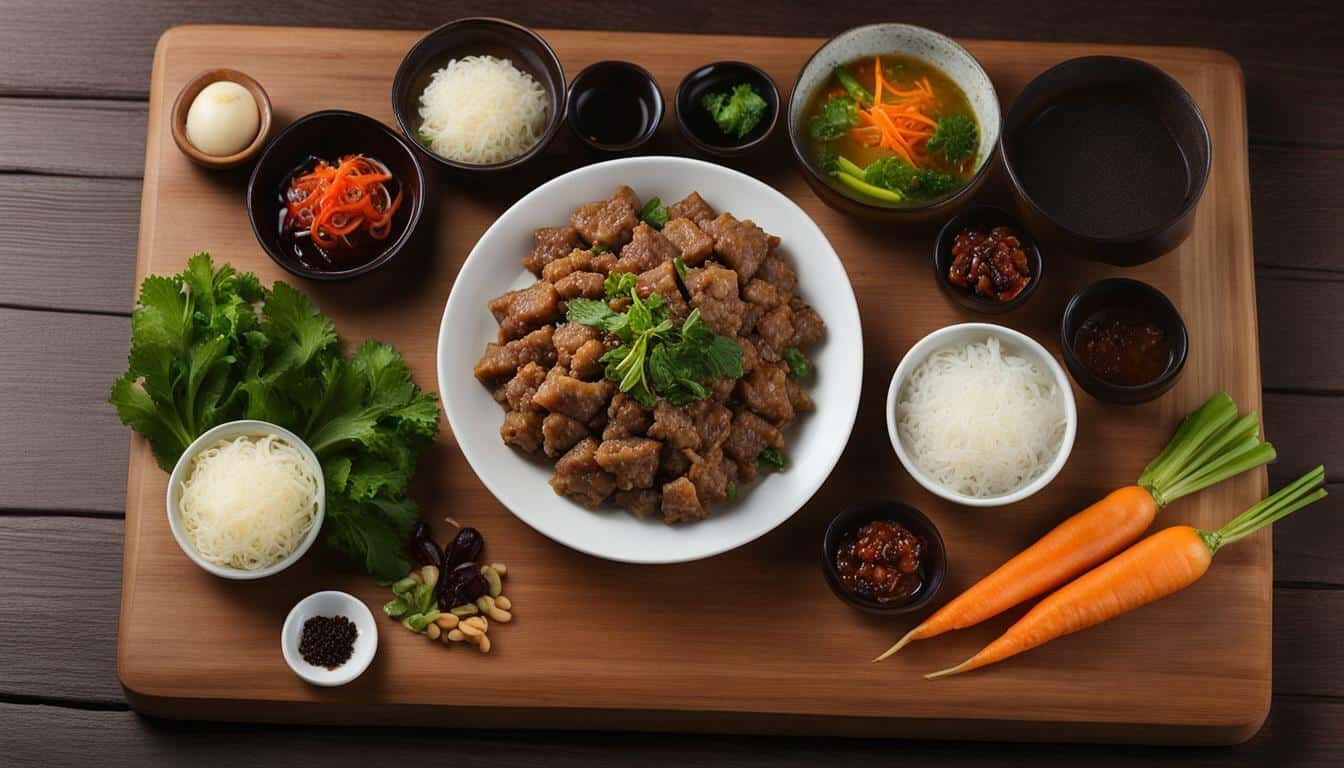
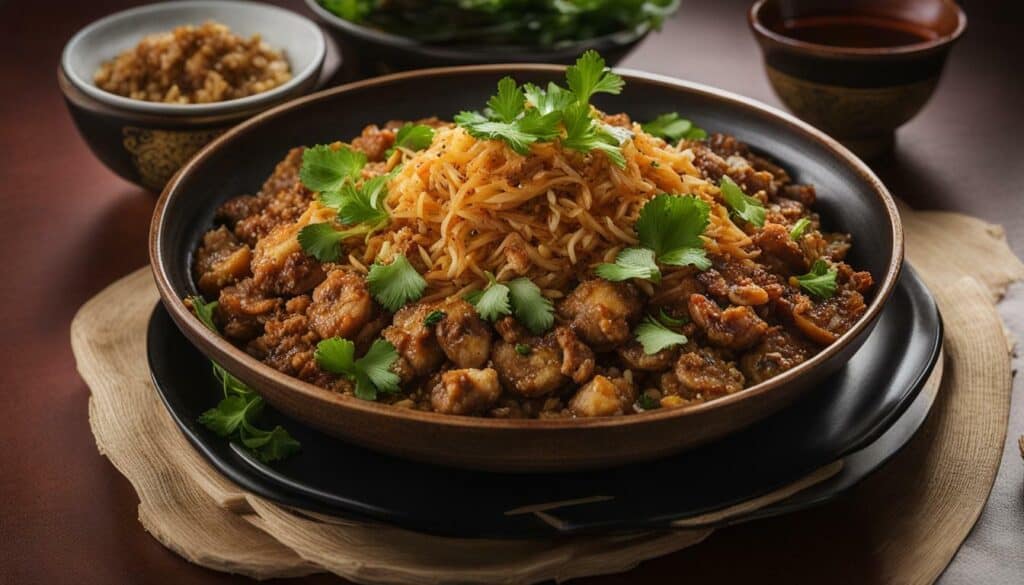
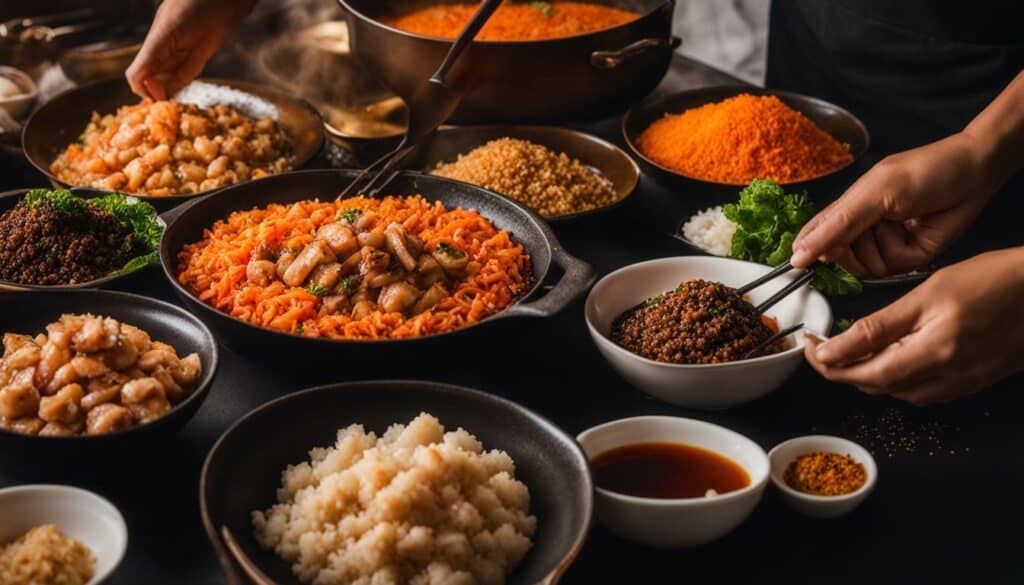
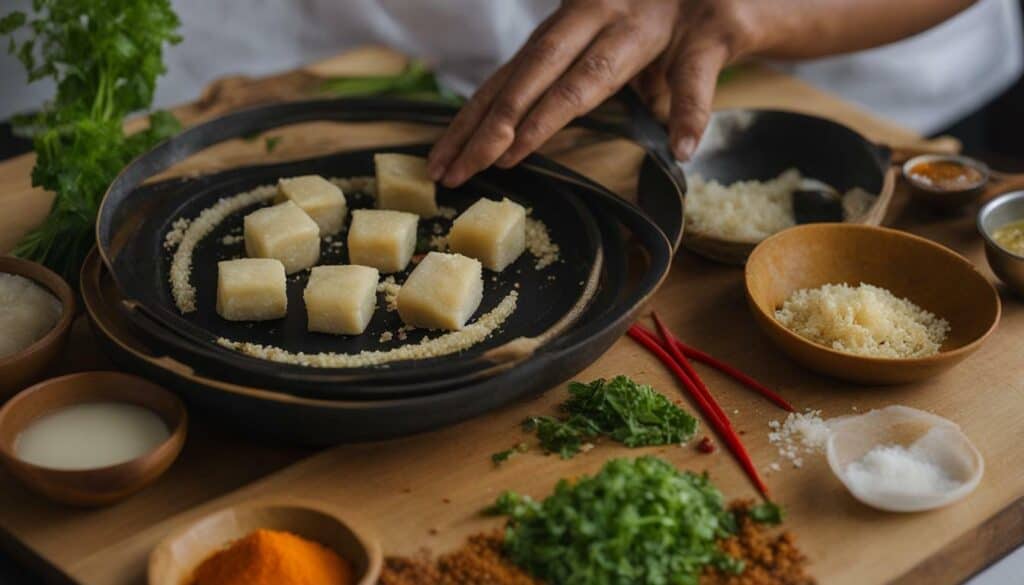
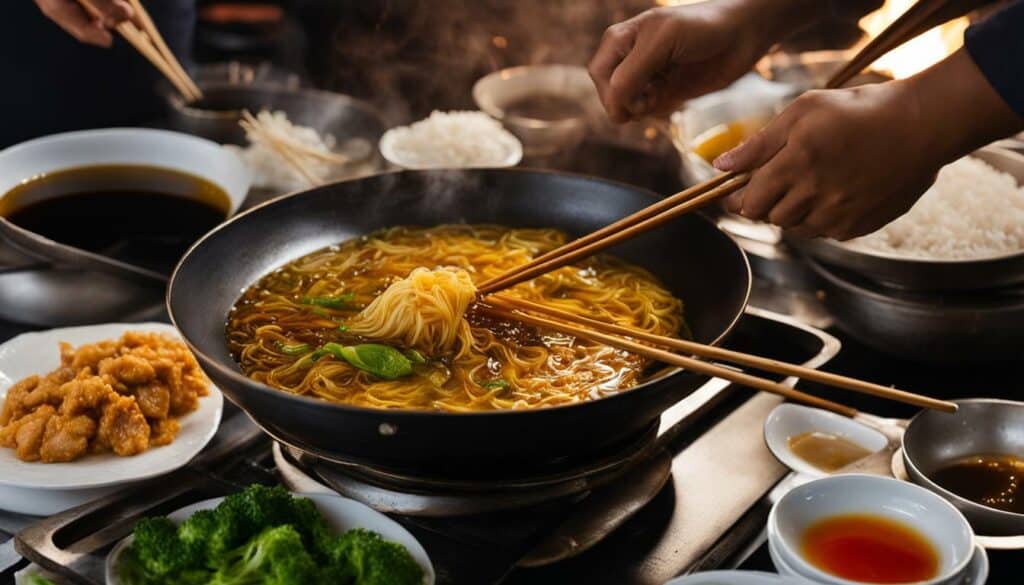
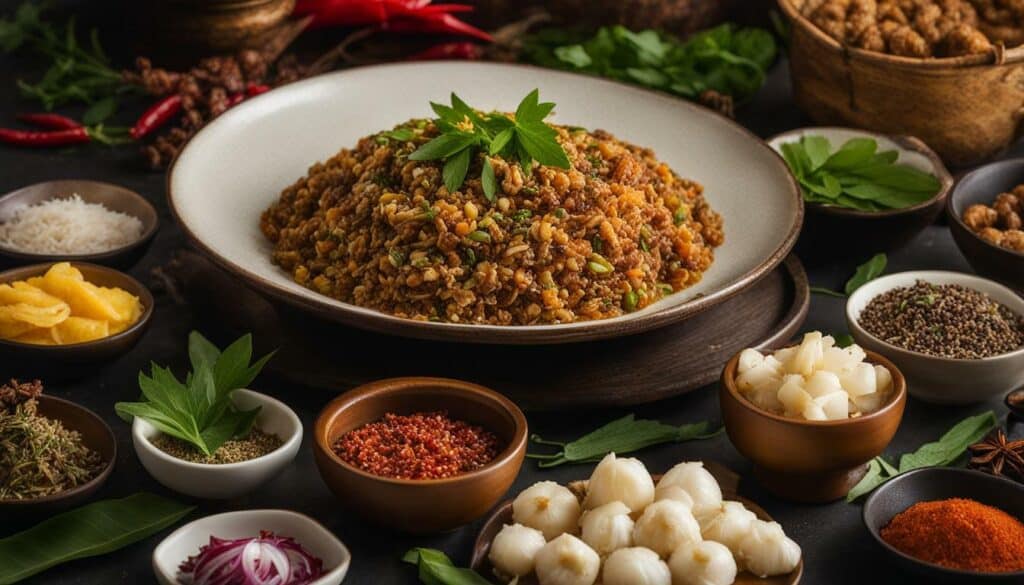
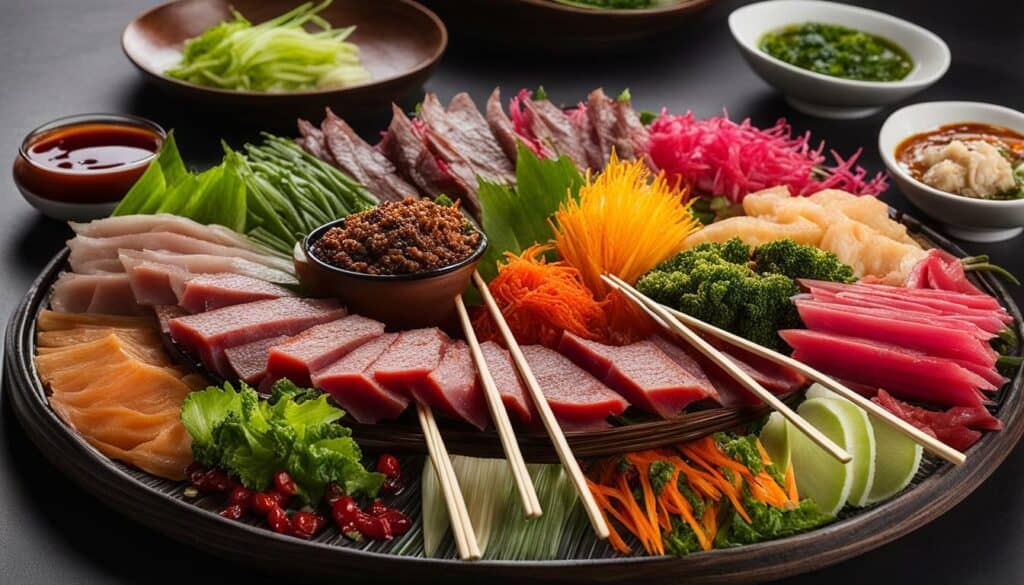




Leave a Reply